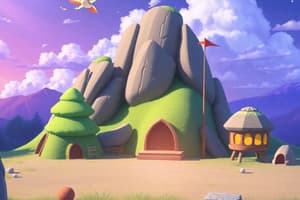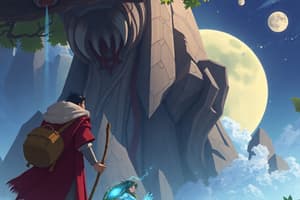Podcast
Questions and Answers
What is emphasized in the characters' development according to the content?
What is emphasized in the characters' development according to the content?
Psychological and emotional development
What are symbols and metaphors used for in character development?
What are symbols and metaphors used for in character development?
- To establish plot twists
- To convey deeper themes (correct)
- To introduce action sequences
- To define physical appearances
Characters in stories should generally have multidimensional personalities.
Characters in stories should generally have multidimensional personalities.
True (A)
Who is the protagonist of Pixar's 'Up'?
Who is the protagonist of Pixar's 'Up'?
Match the character types with their descriptions:
Match the character types with their descriptions:
What role does inspiration play in crafting unique stories?
What role does inspiration play in crafting unique stories?
Inspired stories often resonate more deeply with audiences.
Inspired stories often resonate more deeply with audiences.
What can drawing from diverse sources of inspiration add to a story?
What can drawing from diverse sources of inspiration add to a story?
Hayao Miyazaki often draws upon his childhood memories and personal feelings in his ______.
Hayao Miyazaki often draws upon his childhood memories and personal feelings in his ______.
What is animation?
What is animation?
What are the main stages of the animation process?
What are the main stages of the animation process?
3D Animation is widely used in live-action movies and video games.
3D Animation is widely used in live-action movies and video games.
Stop Motion Animation involves bringing ______ to life by taking pictures of them one after the other.
Stop Motion Animation involves bringing ______ to life by taking pictures of them one after the other.
Match the following with their respective animation types:
Match the following with their respective animation types:
Flashcards are hidden until you start studying
Study Notes
Experimentation and Exploration in Character Development
- Characters experiment with complex relationships, such as unconventional family dynamics, unexpected friendships, and romantic relationships that test boundaries.
- These relationships provide insight into personality and stimulate growth.
- Emphasis on psychological and emotional development of characters, examining how personal experiences, traumas, and triumphs shape character development.
Use of Symbols and Metaphors
- Symbols and metaphors are used to develop characters and indicate larger, deeper themes.
- Examples include a character representing freedom, corruption, or change.
Successful Character Development Examples
- Buzz Lightyear: a hero who is brave, strong, but also arrogant and naively optimistic.
- Buzz Lightyear represents the concept of the "toy that thinks it's real", creating a comedic contrast with other characters.
- His personality is demonstrated through his visual design as a spaceman with solid colors and sharp lines, distinct movements, and confident speaking style.
Carl Fredricksen
- Protagonist of Pixar's "Up"
- Elderly widower with a love for adventure, voiced by Ed Asner
- Carl's life story includes his childhood dream to visit Paradise Falls, meeting and bonding with Ellie, and unfulfilled promises to travel.
Importance of Story in Animation
- The story is the element that draws the audience in and makes them feel connected to the characters and events.
- Emotional engagement is achieved through relatable characters, compelling narrative arcs, and universal themes.
Elements of a Story
- Plot: the backbone of the story, providing structure and direction, with a clear beginning, middle, and end, and engaging turning points.
- Characters: with depth and relatability, unique personalities, motivations, and flaws, making them feel genuine and multidimensional.
- Theme: the underlying message or concept explored in the story, influencing the characters' actions and the plot's progression.
- Setting: the time and place in which the story unfolds, shaping the characters' actions, reflecting the story's themes, and creating a distinct atmosphere.
Implementing the Story in Animation
- Writing a detailed script with dialogues and visual descriptions of movements and settings.
- Turning the script into a storyboard, illustrating the scenes of the story sequentially.
- Determining the timing of each scene and movement to ensure a smooth and engaging flow.
- Focusing on facial expressions and body movements to effectively convey emotions.
Example: Toy Story by Pixar
- Release Year: 1995
- Directed by: John Lasseter
- Produced by: Pixar Animation Studios
- Distributed by: Walt Disney Pictures
- Plot Overview: introduces a world where toys come to life, with Woody and Buzz Lightyear as main characters, exploring themes of friendship, loyalty, and identity.
- Characters: Woody, Buzz Lightyear, and supporting characters, adding depth and humor to the story.
- Story Theme: friendship and loyalty, emphasizing the importance of adapting to change and accepting one's identity.
- Setting: Andy's room and Sid's house, contrasting environments highlighting the journey of Woody and Buzz.
- Impact and Legacy: innovation in CGI, emotional connection with audiences, and spawning multiple sequels.Here are the study notes for the provided text:
The Importance of Character and Story
- Characters and stories are the engine of creative work
- They help attract the audience and build a relationship with them
- They add life and authenticity to the work
Steps for Character Development
- The background: understand the character's story, ambitions, and fears
- The character itself: understand its salient features and how it interacts with other characters
- The appearance: how can visual design reflect personality and make it distinctive?
Inspiration for Designing Animated Characters
- Observe people and human behaviors: observe facial expressions, movements, and interactions
- Study literary, film, and television characters: understand how they are built and develop over time
- Research into history and different cultures: understand cultural customs, traditions, and behaviors
- Study of nature and the surrounding environment: observe animal movements, interactions, and natural phenomena
- Using other arts: music, painting, sculpture, dance, and theatre can inspire character design
- Inspiration from personal memories and experiences: recall situations and people that affected you
- Follow current trends and popular culture: blend elements of fashion, technology, music, politics, and social events into character design
- Experimentation and exploration: innovate in personal characteristics, and explore interactions between characters and the environment
Studying That Suits You
Use AI to generate personalized quizzes and flashcards to suit your learning preferences.




